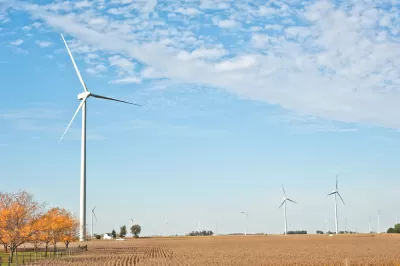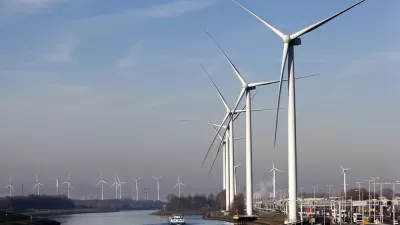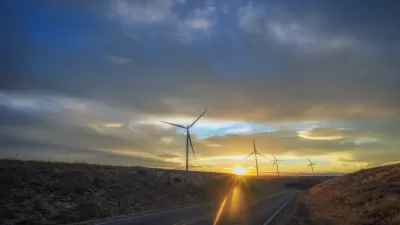Airborne wind turbines and batteries are just two technological advancements pushing the next generation of wind energy.

Like any other technology that’s had to fight for legitimacy among more fully established alternatives, wind power is experiencing significant advancements as well as growing pains.
Recent technological breakthroughs—and even some more modest improvements—have made wind power more accessible and cheaper to adopt, but the industry is not without its challenges.
It’s a frustrating situation, given that every dispatch from the scientific community seems to confirm that human influence on the planet’s climate has been more destructive and fast-moving than we knew. The need for renewable energy is very real, and recent politicking notwithstanding, wind looks like an obvious inclusion in America’s clean power resume.
So—what hurdles still hold back the implementation of more wind turbines across the United States, and what should city and energy planners consider when thinking about planning a new wind farm? Here’s where things stand.
Advancement: Larger Turbines Improve Efficiency and Performance
Over the last five years or so, the average diameter of new wind turbine rotors has slowly crept upward. Energy industry professionals have become ever more confident with installing wind turbine technology in a stable way, and it shows in newer-model designs. The 13 percent increase in average rotor diameter presided over an 11 percent expansion in our capacity to generate wind power. Not bad for half a decade’s work.
As long as states and communities have adequate space, building larger turbines has the potential to deliver the best return.
Advancement: Airborne Wind Solutions
If you’d been caught talking about airborne, kite-like wind generation farms just a few years ago, you might’ve been laughed at. Now airborne wind generation is quickly approaching reality.
Several startups and other interested parties have thrown their hat into this ring already, united by a common vision: to power the globe with wind using a method that doesn’t rely on the more familiar ground-based turbines. The apparatuses these intrepid companies have developed so far are designed to answer longer-term challenges with building new power generation plants of any kind: namely, how to keep all the machinery maintained and working as it should.
So, future-minded engineers did what they did best: They took the already simple concept of wind power and distilled it down to its simplest form. Some of the designs so far are breathtakingly graceful and straightforward. They could, and should, inspire a new wave of young civil engineers to take wind seriously and find innovate ways to implement it in society.
Consider the potential of a large, kite-like structure that traverses airspace and doesn’t require nacelles, blades, or towers on the ground. Another vision employs a movable crane-like arm to connect an airborne power-generating craft high above the ground to a small bivouac-style control center below.
Several of these designs are preparing for manufacturing or have reached that stage already. They could soon represent the face of clean power in America.
Advancement: Clean Energy Meets Battery Storage
We can generate all the power we want to, but unless we use it immediately, quite a lot of it goes to waste. That’s why one of the most important recent advancements in wind power has been…batteries. Unsurprisingly, we can look to Tesla here and the inroads it’s made recently on the global stage to combine wind generation with battery storage in a way the world hasn’t seen before.
The same advantages to residential solar or wind installations also apply here: a system will sometimes generate power you can’t use. Other times, you’ll need power at a time when the conditions mean you can’t generate it. Batteries help level out these trouble spots between the whims of the weather and the more predictable cycles of daily life.
Challenge: High Initial Investment
It’s true—powering more homes and infrastructure with wind has the potential to dramatically change the world. In 2016, 26 countries worldwide had more than 1,000 MW of wind power installed—which is great progress. What’s holding us back from a wider rollout?
The first challenge is probably obvious: cost. The barrier of entry for establishing a viable wind turbine site just can’t compete with electricity generated from more conventional means. Until the initial investment comes down to match or undercut generators powered by fossil fuels, this will remain a stumbling block.
Challenge: Geography
Think about the physical properties of ideal wind generation sites. With few exceptions, the sites that best suit wind generation aren’t close to population centers the way conventional power plants allow. This means we need to build lengthy and expensive transmission lines to get the power from where it’s generated to where it needs to be used.
The American Wind Energy Association estimates that the United States could expand wind energy’s share of electricity generation to 35 percent by 2050, if we got serious about electricity transmission projects. When civil engineering and public interest groups lobby local and state governments to invest in infrastructure improvements, this is part of what they’re talking about. You can help write those letters and send around those petitions, too.
Challenge: Real and Perceived Environmental Nuisance
People are picky. Some folks, like this writer, look at a wind turbine and see progress—possibly even beauty. Others see things differently. President Trump threatened legal action to save the view from one of his golf courses when an offshore windfarm began to take shape there.
The good news is, this problem can be solved the way every technology adoption problem is solved: with a good, old-fashioned public awareness campaign. It is a fact that wind generation technology is cleaner and safer than virtually all the power generation methods we’re more familiar with. This technology isn’t a hard sell—but it might mean engineers and PR people have to team up to make the pitch together.
This is important because wind power also has to contend with a host of misconceptions, including the idea that it harms birds and other wildlife. It’s true that birds sometimes meet untimely ends by flying into turbine blades, but official and unofficial groups are actively looking at practical solutions, up to and including more deliberate placement of the wind farms themselves.
The Future Doesn’t Wait
You’re right to feel a little dismayed at the state of energy policy in the United States and elsewhere.
The good news is, the march of technology and the very public demand for cleaner and less ethically fraught energy continues to push wind and other renewables to exciting new places.
With the right attitude, communication, and technology, wind will soon become a major player in American energy. That’s a great thing for everybody involved.

Trump Administration Could Effectively End Housing Voucher Program
Federal officials are eyeing major cuts to the Section 8 program that helps millions of low-income households pay rent.

Planetizen Federal Action Tracker
A weekly monitor of how Trump’s orders and actions are impacting planners and planning in America.

Ken Jennings Launches Transit Web Series
The Jeopardy champ wants you to ride public transit.

Crime Continues to Drop on Philly, San Francisco Transit Systems
SEPTA and BART both saw significant declines in violent crime in the first quarter of 2025.

How South LA Green Spaces Power Community Health and Hope
Green spaces like South L.A. Wetlands Park are helping South Los Angeles residents promote healthy lifestyles, build community, and advocate for improvements that reflect local needs in historically underserved neighborhoods.

Sacramento Plans ‘Quick-Build’ Road Safety Projects
The city wants to accelerate small-scale safety improvements that use low-cost equipment to make an impact at dangerous intersections.
Urban Design for Planners 1: Software Tools
This six-course series explores essential urban design concepts using open source software and equips planners with the tools they need to participate fully in the urban design process.
Planning for Universal Design
Learn the tools for implementing Universal Design in planning regulations.
Heyer Gruel & Associates PA
Ada County Highway District
Institute for Housing and Urban Development Studies (IHS)
City of Grandview
Harvard GSD Executive Education
Toledo-Lucas County Plan Commissions
Salt Lake City
NYU Wagner Graduate School of Public Service






























